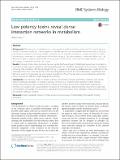Low potency toxins reveal dense interaction networks in metabolism
Author(s)
Bains, William
Download12918_2016_Article_262.pdf (1.625Mb)
PUBLISHER_CC
Publisher with Creative Commons License
Creative Commons Attribution
Terms of use
Metadata
Show full item recordAbstract
Background
The chemicals of metabolism are constructed of a small set of atoms and bonds. This may be because chemical structures outside the chemical space in which life operates are incompatible with biochemistry, or because mechanisms to make or utilize such excluded structures has not evolved. In this paper I address the extent to which biochemistry is restricted to a small fraction of the chemical space of possible chemicals, a restricted subset that I call Biochemical Space. I explore evidence that this restriction is at least in part due to selection again specific structures, and suggest a mechanism by which this occurs.
Results
Chemicals that contain structures that our outside Biochemical Space (UnBiological groups) are more likely to be toxic to a wide range of organisms, even though they have no specifically toxic groups and no obvious mechanism of toxicity. This correlation of UnBiological with toxicity is stronger for low potency (millimolar) toxins. I relate this to the observation that most chemicals interact with many biological structures at low millimolar toxicity. I hypothesise that life has to select its components not only to have a specific set of functions but also to avoid interactions with all the other components of life that might degrade their function.
Conclusions
The chemistry of life has to form a dense, self-consistent network of chemical structures, and cannot easily be arbitrarily extended. The toxicity of arbitrary chemicals is a reflection of the disruption to that network occasioned by trying to insert a chemical into it without also selecting all the other components to tolerate that chemical. This suggests new ways to test for the toxicity of chemicals, and that engineering organisms to make high concentrations of materials such as chemical precursors or fuels may require more substantial engineering than just of the synthetic pathways involved.
Date issued
2016-02Department
Massachusetts Institute of Technology. Department of Earth, Atmospheric, and Planetary SciencesJournal
BMC Systems Biology
Publisher
BioMed Central
Citation
Bains, William. “Low Potency Toxins Reveal Dense Interaction Networks in Metabolism.” BMC Syst Biol 10, no. 1 (February 20, 2016).
Version: Final published version
ISSN
1752-0509